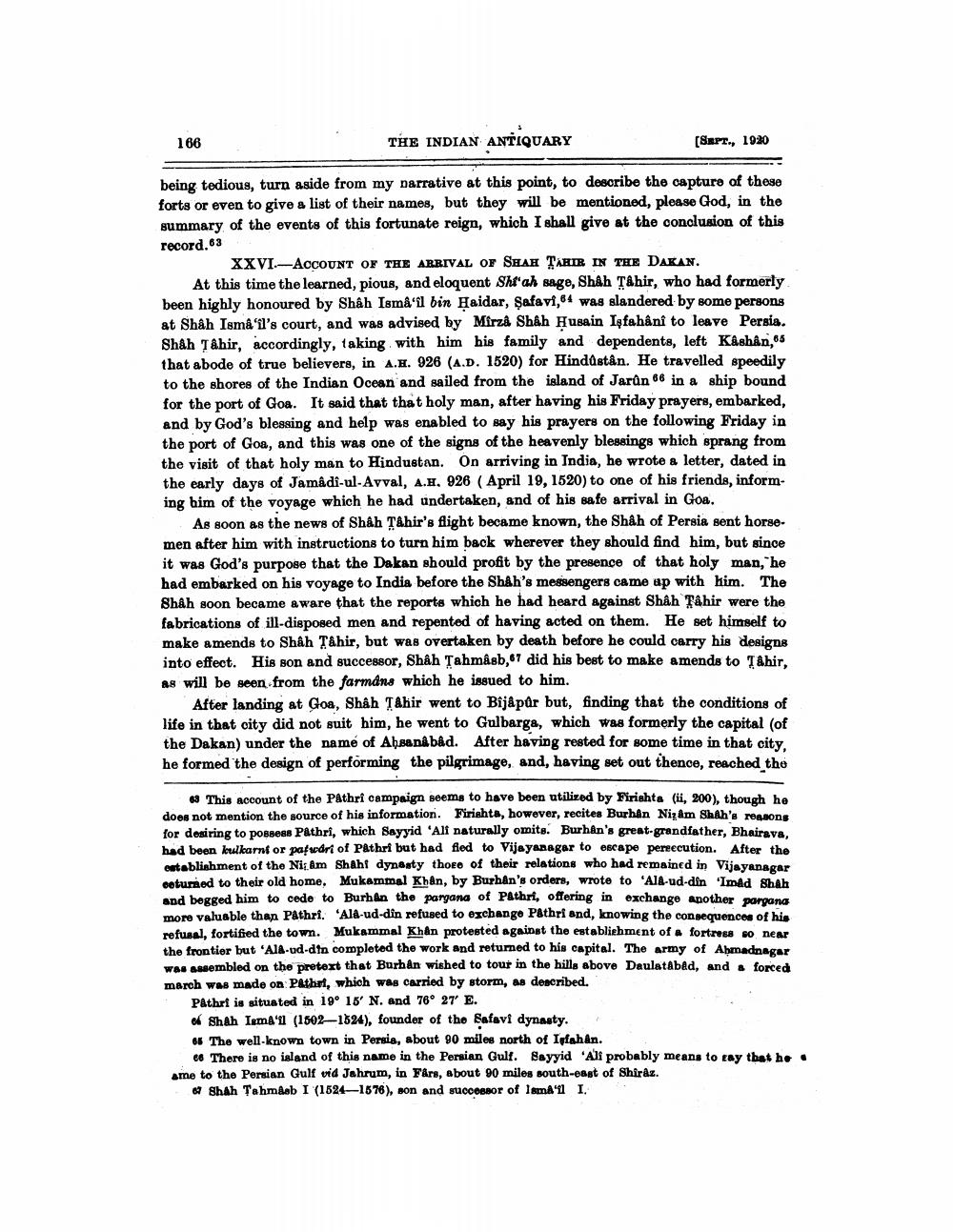________________
166
THE INDIAN ANTIQUARY
(SAPT., 1920
being tedious, turn aside from my narrative at this point, to describe the capture of these forts or even to give a list of their names, but they will be mentioned, please God, in the summary of the events of this fortunate reign, which I shall give at the conclusion of this
record. 63
XXVI.-ACCOUNT OF THE ARRIVAL OF SHAH TAHIR IN THE DAKAN. At this time the learned, pious, and eloquent Shi'ah sage, Shah Tâhir, who had formerly been highly honoured by Shah Ismå'il bin Haidar, Şafavi,64 was slandered by some persons at Shah Isma'il's court, and was advised by Mirza Shah ķusain Isfahânî to leave Persia. Shah Tâhir, accordingly, taking with him his family and dependents, left Kåshận,65 that abode of true believers, in A.H. 926 (A.D. 1520) for Hindustan. He travelled speedily to the shores of the Indian Ocean and sailed from the island of Jarûn 66 in a ship bound for the port of Goa. It said that that holy man, after having his Friday prayers, embarked, and by God's blessing and help was enabled to say his prayers on the following Friday in the port of Goa, and this was one of the signs of the heavenly blessings which sprang from the visit of that holy man to Hindustan. On arriving in India, he wrote a letter, dated in the early days of Jamâdî-ul-Avval, A.H. 926 (April 19, 1520) to one of his friends, informing him of the voyage which he had undertaken, and of his safe arrival in Goa.
As soon as the news of Shah TAhir's flight became known, the Shah of Persia sent horsemen after him with instructions to turn him back wherever they should find him, but since it was God's purpose that the Dakan should profit by the presence of that holy man," he had embarked on his voyage to India before the Shah's messengers came ap with him. The ShAh soon became aware that the reports which he had heard against Shah Tahir were the fabrications of ill-disposed men and repented of having acted on them. He set himself to make amends to Shah Tahir, but was overtaken by death before he could carry his designs into effect. His son and successor, Shah Tahmåsb,67 did his best to make amends to TÅhir, as will be seen from the farmáns which he issued to him.
After landing at Goa, Shah Tahir went to Bijâ par but, finding that the conditions of life in that city did not suit him, he went to Gulbarga, which was formerly the capital (of the Dakan) under the name of Absanabad. After having rested for some time in that city, he formed the design of performing the pilgrimage, and, having set out thence, reached the
63 This account of the Pathri campaign seems to have been utilized by Firishta (li, 200), though he does not mention the source of his information. Firishta, however, recites Burhan Nizam Shah's me . for desiring to possess Pathri, which Sayyid 'Ali naturally omits. Burhan's great-grandiather, Bhairava. had been kulkarni or patsdri of Pathri but had fled to Vijayanagar to escape persecution. After the establishment of the Nizam Shahf dynasty those of their relations who had remained in Vijayanagar eeturned to their old home. Mukammal Khan, by Burhan's orders, wrote to 'AIA-ud-din 'Imad ShAh and begged him to cede to Burhan the pargana of Pathri, offering in exchange another porgana more valuable than Pathri. 'Ald-ud-din refused to exchange Pathri and, knowing the consequences of his refusal, fortified the town. Mukammal Khan protested against the establishment of fortresa so near the frontier but 'ATA-ud-din completed the work and returned to his capital. The army of Ahmadnagar Y sembled on the pretext that Burhan wished to tour in the hills above Daulatabad, and forced march was made on Pathr, which was carried by storm, as described.
Pathrt is situated in 19° 15' N. and 76° 27' E. of Shah Isma'11 (1502-1524), founder of the Safavi dynasty. 66 The well-known town in Persia, about 90 miles north of Ipfahan.
€ There is no island of this name in the Persian Gulf. Sayyid 'All probably means to tay that he . ame to the Persian Gulf vid Jahrum, in F&rs, about 90 miles south-east of Shiraz.
89 Shah Tahmob I (1524—1576), aon and successor of IamA'11 I.




